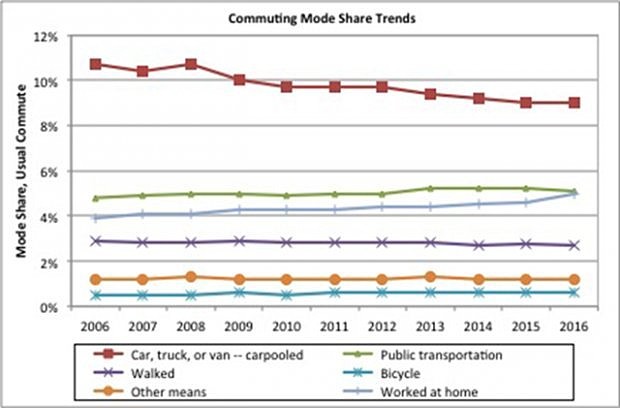- December 13, 2025
-
-
Loading

Loading

I’ve been attending a fascinating series of events about local transportation called “Grid Un-Locked” put on by the Greater Sarasota Chamber of Commerce, the Gulf Coast Community Foundation and SRQ Media. I’ve been learning a lot from it, and it has provoked me to some new thinking about public transit in Sarasota.
How bad is traffic in Sarasota?
I can hear you laughing at that question, since we all know it’s a real problem, especially during season. The first presentation of the Grid Un-Locked series, by Demian Miller from the transportation planning firm Tindale Oliver, shed some interesting light on the question.
The shocker was the data showing that overall total traffic in Sarasota is almost unchanged over the past 15 years. But the problem is where the traffic is occurring. Miller presented traffic count data showing that while traffic on Tamiami Trail has changed little over a decade and half, it has increased noticeably on Fruitville, for example, and has increased a lot on the Ringling Causeway.
While there is not more traffic overall in Sarasota, there is more traffic in the places where more of us travel. That’s how congestion works. And it means Sarasota’s most urgent transportation needs are tied to specific parts of the network.
Increasing transit use, rather than driving, seems crucial to providing regional mobility as Sarasota’s population, economy and number of tourists grow. But even the most ardent supporter of transit has to recognize that our transit system faces some major challenges.
The first challenge is getting people to use transit. Steve Polzin at the Center for Urban Transportation Research at the University of South Florida recently analyzed the latest data from the Census Bureau’s American Community Survey on how people travel.
Look at the figure provided above on commuter mode share trends (the top line is carpooling). Transit tends to serve commuters better than noncommute travel, so the performance for noncommute travel, which is vital in Sarasota, is likely much worse. In 10 years, transit has barely increased its market share. Even working at home increased more than transit use. This despite the fact that metropolitan areas spend at least 4-5 times as much per transit user as they do per highway user. Which indicates we need to think about new ways to provide transit to appeal to riders. Especially in Sarasota, where are transit needs are the effect of ride-sharing.
The second presentation in the Grid Un-Locked series, by Richard Biter, a senior executive at the Florida Department of Transportation, pointed out how dramatically ride-sharing services like Uber and Lyft and many others are affecting travel, and the challenge that presents to public transit services.
His point was driven home in mid-October when researchers at the University of California, Davis, released the results of the most extensive study yet of the effects of ride-sharing on travel. They examined the travel behavior of 4,000 people in Boston, Chicago, Los Angeles, New York, San Francisco, Seattle and Washington, D.C. For starters they found that 21% of all adults use ride-sharing services, and that jumps to 36% among those 18-29 years old. Even in the suburbs, the number of adults using ride-sharing is 7%.
Those numbers are considerably higher than the number who use public transit in those cities—except New York.
The figure provided on changes in transit use, biking and walking after adoption of ride-hailing services comes from the UC Davis study. Notice that ride-sharing is a replacement for standard urban bus and light rail transit, but a boost for commuter rail and walking, which pair up with ride-sharing to make trips easier.
This reinforces decades of data showing that in households with no car, more trips are taken in other people’s cars than by public transit. It seems like any form of using a car is preferred by most people over the transit services they have available.
All of this means that standard bus and light rail transit services have been losing in competition with driving, and that is only getting worse with ride-sharing service innovations and autonomous vehicles are on the horizon.
Going back to the traffic trends in Sarasota, public transit needs to focus on options in those most traveled corridors where traffic is the worst and growing. A more focused transit system can more readily put resources into improving the quality of buses and the riding experience to make it more attractive. And for transit-dependent people in the less traveled corridors, it might make sense to provide transit vouchers that can be used for ride-sharing and paratransit services.
Targeting tourist traffic is also crucial in Sarasota. The Siesta Trolley is by all accounts a success and a model for a simple service designed to make it easy for tourists. Likewise the downtown I-Ride service can grow to serve more tourists. Providing mainland parking structures and shuttles to beaches can help on area bridges, as might improved transit from Lido and Longboat keys to downtown to help relieve traffic on the Ringling.
Finally, since there are probably no major new resources in the offing to pay for transit, managing costs and improving quality will be crucial. FDOT’s Biter emphasized in his Grid Un-Locked presentation the success a great many transit systems have had with public-private partnerships, and they are “becoming the norm, rather than the exception.” Indeed, the DeVoe Moore Center at Florida State has done great work gathering the lessons learned for success from many transit systems that use public-private partnerships to expand and improve services. So there is a lot Sarasota can build upon.
Transit must have an important role in the future of mobility in Sarasota, but only if we adjust with changing travel trends and technology and customize our system to the very particular needs of our area. It’s a challenge, but it can be done.
Adrian Moore is vice president of the Reason Foundation and lives in Sarasota.